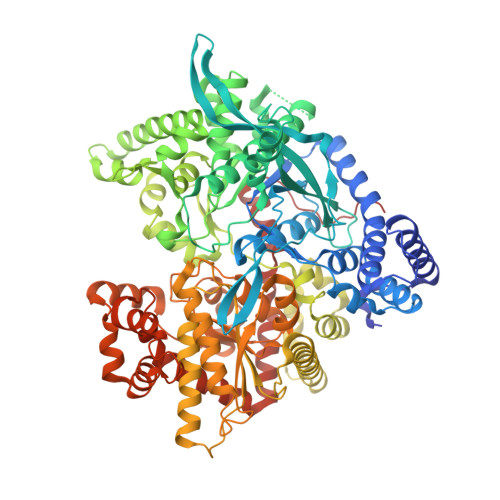The architecture of hydrogen and sulfur sigma-hole interactions explain differences in the inhibitory potency of C-beta-d-glucopyranosyl thiazoles, imidazoles and an N-beta-d glucopyranosyl tetrazole for human liver glycogen phosphorylase and offer new insights to structure-based design.
Kyriakis, E., Karra, A.G., Papaioannou, O., Solovou, T., Skamnaki, V.T., Liggri, P.G.V., Zographos, S.E., Szennyes, E., Bokor, E., Kun, S., Psarra, A.G., Somsak, L., Leonidas, D.D.(2020) Bioorg Med Chem 28: 115196-115196
- PubMed: 31767404
- DOI: https://doi.org/10.1016/j.bmc.2019.115196
- Primary Citation of Related Structures:
6S4H, 6S4K, 6S4O, 6S4P, 6S4R, 6S51, 6S52 - PubMed Abstract:
C-Glucopyranosyl imidazoles, thiazoles, and an N-glucopyranosyl tetrazole were assessed in vitro and ex vivo for their inhibitory efficiency against isoforms of glycogen phosphorylase (GP; a validated pharmacological target for the development of anti-hyperglycaemic agents). Imidazoles proved to be more potent inhibitors than the corresponding thiazoles or the tetrazole. The most potent derivative has a 2-naphthyl substituent, a K i value of 3.2 µM for hepatic glycogen phosphorylase, displaying also 60% inhibition of GP activity in HepG2 cells, compared to control vehicle treated cells, at 100 μM. X-Ray crystallography studies of the protein - inhibitor complexes revealed the importance of the architecture of inhibitor associated hydrogen bonds or sulfur σ-hole bond interactions to Asn284 OD1, offering new insights to structure-based design efforts. Moreover, while the 2-glucopyranosyl-tetrazole seems to bind differently from the corresponding 1,2,3-triazole compound, the two inhibitors are equipotent.
- Department of Biochemistry and Biotechnology, University of Thessaly, Biopolis, 41500 Larissa, Greece.
Organizational Affiliation:



















